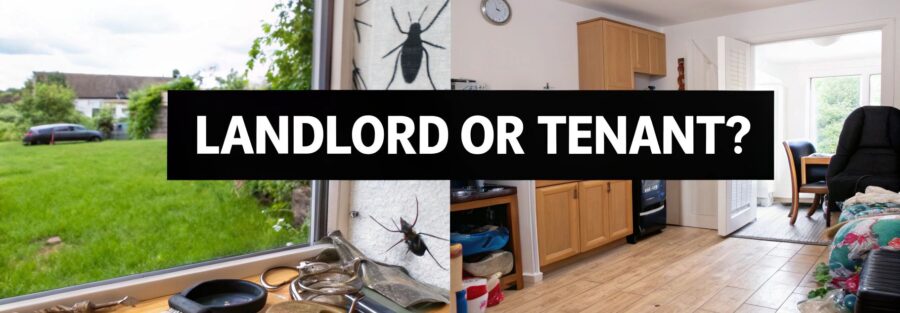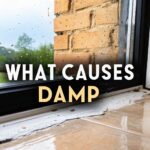When pests show up uninvited, the first question on everyone's mind is always: who’s responsible, the landlord or the tenant? It’s a classic rental headache, and the answer usually comes down to two things: what caused the pest problem and what’s written in your tenancy agreement.
As a general rule, landlords are on the hook for pre-existing issues or problems that pop up because of structural faults. On the other hand, tenants are typically responsible for pests that are attracted by their day-to-day habits.
Who Really Foots the Bill for Pest Control?

Figuring out who pays for pest control is one of the most common friction points between landlords and tenants. This isn't just about who makes the call; it's about legal duties that protect both sides.
Think of a rental property like a ship. The landlord’s job is to provide a "seaworthy" vessel from day one, meaning it should be free from any holes or cracks that let pests climb aboard.
This isn’t just good practice; it's a legal requirement in the UK. Under The Homes (Fitness for Human Habitation) Act 2018, landlords have a clear duty to make sure their properties are safe and healthy. If pests were already hiding out before a tenant moved in, or if they’re getting in through a leaky pipe or a hole in the wall, the responsibility falls squarely on the landlord’s shoulders.
Of course, a tenant's lifestyle can completely change the game. How you live in a property directly impacts whether it becomes a magnet for pests.
The Tenant's Role in Keeping Pests Out
Every tenant is expected to live in a "tenant-like manner." It sounds a bit old-fashioned, but it’s a crucial phrase when it comes to pest control. It simply means you need to do the basic, reasonable things to keep the property clean and hygienic.
So, when does the responsibility shift? It usually happens if an infestation is a direct result of a tenant's actions, such as:
- Leaving rubbish out: Overflowing bins are basically a 24/7 buffet for rats, mice, and insects.
- Poor housekeeping: Crumbs on the floor, dirty dishes left in the sink, and food spills are an open invitation to ants and cockroaches.
- Bringing pests home with you: It's easier than you think. Bed bugs, for example, are notorious hitchhikers and can sneak in on luggage or second-hand furniture.
In situations like these, the tenant’s behaviour is the root cause of the problem, which means they are liable for the extermination costs.
To make things crystal clear, here’s a quick summary of who is typically responsible in different scenarios.
Pest Control Responsibility At a Glance
| Scenario | Likely Responsible Party | Reasoning |
|---|---|---|
| Pests were present at move-in | Landlord | The property was not in a habitable condition from the start of the tenancy. |
| Rats getting in through a hole in the wall | Landlord | This is a structural issue. The landlord must maintain the property's exterior and structure. |
| A mouse problem caused by overflowing bins | Tenant | The infestation is a direct result of the tenant's actions (or lack thereof) regarding waste disposal. |
| Bed bugs arrive after a holiday | Tenant | The pests were introduced to the property by the tenant or their belongings. |
| Wasps build a nest in the loft | Landlord | Wasp nests are considered a structural issue that affects the property's safety and habitability. |
This table is a general guide, and specific tenancy agreements or local council rules can sometimes change things. But understanding these core principles is the first step to knowing your rights and responsibilities.
Understanding a Landlord’s Legal Duties
When you’re staring down a pest problem, the first question is always, "who sorts this out?" In the UK, the answer often starts with the landlord's core legal obligations. This isn't some grey area left to chance; the law sets a pretty clear standard for rental properties.
The big one to know is The Homes (Fitness for Human Habitation) Act 2018. This piece of legislation basically says a property must be safe, healthy, and free from hazards for the entire tenancy. And yes, a serious pest infestation definitely counts as a hazard.
This means a landlord is almost always responsible for infestations that pop up because of the property's condition. Think of the building’s structure as its first line of defence against pests. If that defence is weak, it’s up to the landlord to make it right.
The Standard of a Habitable Home
So, what does a "habitable" home actually mean when we're talking about pests? It's not just about a quick glance around on move-in day to check for critters. It goes much deeper than that – it’s about the underlying state of the building itself.
The law expects landlords to deal with problems that could invite pests in or help them thrive. For example, if mice are nipping through a crack in the foundation like it’s their own private entrance, sealing that crack is the landlord's job. Same goes for a bathroom with persistent damp that’s become a five-star hotel for silverfish or cockroaches; the landlord has to fix the source of the damp.
The landlord’s duty is proactive, not just reactive. It's about making sure the property itself isn’t the root cause of the infestation, protecting tenants from problems they simply can't control.
This responsibility kicks in from day one of the tenancy. A landlord can't knowingly rent out a place with an obvious structural flaw that's a magnet for pests and then try to pass the buck when the inevitable happens.
When is the Landlord Definitely on the Hook?
To make it crystal clear, let's look at a few classic scenarios where the responsibility lands squarely on the landlord's shoulders:
- Pre-existing Problems: If tenants move in and report a mouse problem within days, it’s a safe bet the issue was there before they arrived. The landlord needs to get it sorted.
- Structural Failings: A tenant hears scratching and discovers squirrels have moved into the loft through a hole in the roof. Fixing the roof and getting rid of the uninvited guests is the landlord's responsibility.
- Communal Area Issues: If a rat problem starts because of poorly maintained communal bins in a block of flats, that’s on the landlord or the property management company to resolve.
At the end of the day, if the pest problem can be traced back to the building’s structure, its state of repair, or shared spaces, the landlord is legally required to step in. Of course, managing a property involves more than just maintenance; landlords also need to get their heads around things like rental property tax deductions to run things smoothly. Dealing with issues like pests promptly isn't just about ticking legal boxes—it's a massive part of being a responsible landlord.
When The Tables Turn: Tenant Responsibility for Pests

While landlords have their legal duties, pest control isn't a one-way street. A tenant's actions—or lack thereof—can directly cause an infestation, shifting the responsibility and the cost squarely onto their shoulders. This is where the idea of acting in a "tenant-like manner" comes into play.
It’s a simple concept, really. It just means looking after the property to a reasonable standard of cleanliness. When a tenant’s lifestyle creates an environment where pests can thrive, they become responsible for dealing with the fallout.
Think of it like this: leaving rubbish bags piled up by the back door for weeks is like putting out a buffet for rats. Similarly, consistently leaving food scraps on worktops and dirty dishes in the sink creates a five-star hotel for cockroaches and ants. These aren't structural problems; they're issues caused directly by how the property is being lived in.
How Everyday Habits Can Invite an Infestation
Understanding how simple daily routines can lead to a pest problem is the key to stopping it before it starts. It’s not about pointing fingers, but about recognising that a tenant’s lifestyle is often the deciding factor in whether a property stays pest-free.
Here are a few common ways tenants can accidentally roll out the welcome mat for pests:
- Improper Waste Disposal: Not using the provided bins correctly or letting them overflow is an open invitation for rodents and insects looking for an easy meal.
- Poor Housekeeping: If you’re not regularly vacuuming or wiping down surfaces, crumbs and food spills build up, feeding pests like ants and mice.
- Bringing Pests Inside: Sometimes, an infestation starts when pests are brought in from outside. Bed bugs are the classic example—they're expert hitchhikers and often arrive on second-hand furniture or in luggage after a holiday.
- Ignoring the Early Signs: Spotting a few ants and doing nothing about it? That small problem can quickly snowball into a full-blown infestation that’s much harder, and more expensive, to fix.
When an infestation is a direct result of a tenant's actions or negligence, the landlord is typically not liable. Proving this often involves demonstrating that the property was pest-free at the start of the tenancy and that the tenant's habits created the problem.
A proactive landlord might carry out routine tenant inspections for pest damage, which can help figure out if an infestation is down to tenant lifestyle or a structural fault.
By understanding these responsibilities, tenants can avoid a nasty surprise and an unexpected bill. Good habits don't just make for a nicer home; they're also the best form of pest defence. For instance, learning how to prevent rats through simple, clean habits is a powerful way to protect both your home and your deposit.
How Your Tenancy Agreement Defines Responsibility

While UK law sets the basic ground rules, your tenancy agreement is the ultimate rulebook for the property. Think of it as the single most important document for heading off pest control disputes before they even start. A clear agreement acts like a pre-emptive peace treaty, outlining exactly who is responsible for what.
When an agreement includes specific clauses about pests, it eliminates guesswork. A well-written contract will clearly detail the tenant’s obligations for cleanliness and the landlord’s duty to keep the building's structure sound. This clarity is what stops a minor issue from spiralling into a major disagreement.
Unfortunately, not all agreements are created equal. A vague or silent contract is often a recipe for conflict. In fact, a 2022 survey revealed that around 60% of pest-related disputes were caused by hazy responsibilities in the tenancy agreement. It’s a stark reminder of just how critical clear documentation is.
What to Look for in a Strong Pest Clause
So, what separates a useful pest clause from a useless one? It all comes down to the specifics. A strong agreement moves beyond vague statements and provides concrete, actionable details.
A good tenancy agreement should clearly state:
- Tenant’s Hygiene Standards: This clause should spell out the tenant's duty to dispose of rubbish correctly, store food properly, and maintain a reasonable level of cleanliness to avoid attracting pests.
- Landlord’s Structural Duties: It needs to confirm the landlord’s responsibility for fixing structural problems like holes in walls, roofs, or foundations that could give pests an open invitation.
- Reporting Procedures: The agreement must specify how and when a tenant should report a suspected infestation, ensuring issues can be tackled quickly.
To ensure all responsibilities are crystal clear, landlords and tenants can use tools like a free rental agreement template.
Example of a weak clause: "The tenant must keep the property clean." This is far too vague and open to interpretation.
Example of a strong clause: "The tenant is responsible for the routine disposal of all household waste in the designated bins and must report any pest sightings to the landlord in writing within 48 hours."
If your tenancy agreement doesn't mention pests at all, the responsibility automatically falls back on the legal standards set by laws like The Homes (Fitness for Human Habitation) Act 2018. In simple terms, this means the landlord is generally on the hook for infestations caused by structural defects, while the tenant is liable if their actions or negligence are the root cause.
Common Pest Problems and Who Is Liable
Knowing the law is one thing, but applying it when you find mouse droppings in the kitchen is another story entirely. The real answer to "who pays for pest control?" almost always comes down to the specific pest and, crucially, how it managed to get inside.
Let's break down a few of the most common infestations you're likely to face.
This is a pretty typical breakdown of where the costs land when you call in the professionals. As you can see, the financial weight often falls more on the landlord, which makes sense given their duty to keep the property's structure sound.

Who Pays for Common Pest Infestations
To make it even clearer, here's a quick table outlining who is likely responsible in different scenarios. It all boils down to whether the problem stems from a flaw in the building or from the tenant's day-to-day habits.
| Pest Type | Scenario Making Landlord Responsible | Scenario Making Tenant Responsible |
|---|---|---|
| Rodents | Mice are entering through an unrepaired hole around pipework or a gap under a door that existed at move-in. | Overflowing rubbish bins or food left out consistently creates a food source that attracts rats or mice. |
| Bed Bugs | The infestation was present before the tenant moved in, or has spread from an adjacent, infested flat. | The tenant brings bed bugs back in their luggage after a holiday, or on second-hand furniture. |
| Fleas | The infestation was left by a previous tenant's pets and not treated before the new tenancy began. | The tenant's own pet introduces fleas to the property, and the infestation is not managed promptly. |
| Wasps | A nest is found in the loft, attached to the roof eaves, or within the wall cavity. | Extremely rare, but responsibility could shift if the tenant's actions directly caused the nest (e.g., bringing in a queen). |
| Cockroaches | The pests are entering from neighbouring properties or through structural defects like cracked drains. | Poor sanitation, such as unwashed dishes and food spills, provides the ideal environment for cockroaches to thrive. |
Ultimately, a bit of common sense and a good look at the evidence will usually point to the responsible party.
Mice and Rats
Rodents are the classic cause of rental disputes. They are absolute experts at finding a way in, so figuring out who’s at fault means playing detective.
-
Landlord's Responsibility: A tenant moves in and finds droppings almost immediately. A quick look under the sink reveals a big, unsealed gap around a pipe. That’s a clear structural issue. The landlord is on the hook for sealing the hole and getting rid of the mice. For a deeper dive, check out our guide on how mice get into your house.
-
Tenant's Responsibility: The property was given a clean bill of health when the tenancy started. Six months down the line, rats appear. The landlord discovers that rubbish bags are constantly left overflowing by the back door. This is a clear invitation for rodents, making it the tenant's problem to solve.
Bed Bugs
These pests are notorious hitchhikers and a massive source of stress. When it comes to bed bugs, liability almost always hinges on how they got into the property in the first place.
It's a common myth that bed bugs are a sign of a dirty home. The truth is, they couldn't care less about cleanliness. They can infest the most pristine properties because they're brought in from outside, not attracted by grime.
-
Landlord's Responsibility: A new tenant in a block of flats reports bed bugs within their first week. If it turns out other flats in the building have a known, ongoing issue, it’s highly likely the infestation is spreading through the structure. That makes it the landlord's problem.
-
Tenant's Responsibility: Someone comes back from holiday and starts noticing bites a few weeks later. If a pest controller confirms the infestation is centred around their bed and luggage, it’s almost certain they brought the pests home with them. In this case, the tenant has to cover the treatment.
Wasps and Bees
Nests from stinging insects are a clear safety risk. Because they almost always build their nests on the building itself, figuring out who is responsible is usually pretty simple.
-
Landlord's Responsibility: A tenant finds a big wasp nest in the loft or tucked under the eaves of the roof. This is part of the building's structure and makes the property unsafe. The landlord must get it removed professionally and safely.
-
Tenant's Responsibility: This is incredibly rare. A tenant would only be responsible if their actions somehow directly led to the nest being built—like bringing an object onto the property that just happened to contain a queen wasp, which is next to impossible. In 99% of cases, a wasp nest is the landlord’s job.
Your Action Plan for Dealing with Pests
Finding pests in your rental can be a real headache, but having a clear game plan makes all the difference. Whether you're a tenant or a landlord, the key is to act fast and keep a record of everything. This is the best way to sort things out quickly and keep the relationship on good terms.
If you’re a tenant, the second you spot signs of an infestation, it’s time to play detective. Start by documenting everything you see. Clear photos and videos of droppings, gnaw marks, nests, or the pests themselves are worth their weight in gold if a disagreement pops up later.
Next, and this is crucial, you need to tell your landlord immediately—and do it in writing. An email or a formal letter gives you a time-stamped paper trail. In your message, be specific about the problem, explain where you found the evidence, and attach the photos you took.
What Tenants Should Do First
How you handle these first few moments can really set the tone for the entire process. Just follow this simple checklist to make sure you’ve got all your bases covered.
- Gather Proof: Take clear photos and videos. Make a note of the dates, times, and places you've seen any pest activity.
- Notify in Writing: Send a detailed email or letter to your landlord or the letting agent. This makes your request official and gets the ball rolling.
- Review Your Agreement: It's always a good idea to dig out your tenancy agreement and check for any clauses about pest control. It might already spell out who is responsible.
How Landlords Should Respond
For landlords, getting that pest report means it’s time for you to act just as quickly and professionally. Your first move should be to investigate the report to figure out what’s going on. This not only helps get to the bottom of the issue but also shows your tenant you’re taking their concerns seriously and meeting your legal obligations.
Keep the lines of communication wide open. Let your tenant know your plan—when you or a professional will inspect the property and what the next steps are. Being transparent can stop a small problem from blowing up and reassures your tenant that you're on the case.
Collaboration is absolutely essential. A tenant who feels heard and a landlord who acts decisively can sort out a pest issue far more effectively than if both parties retreat into their corners. Quick action protects the property from further damage and makes sure the tenant's home stays safe and habitable.
Ultimately, whether you're the tenant raising the alarm or the landlord responding to it, this is a shared responsibility. Calling in professional pest control services is often the quickest and most reliable way to get rid of the problem for good, giving everyone involved some much-needed peace of mind.
Still Have Questions?
Navigating the rules around pest control can feel like a minefield. To make things clearer, here are direct answers to some of the most common questions we get from both tenants and landlords.
What if My Landlord Ignores My Request for Pest Control?
If your landlord is responsible for the infestation but isn't responding to your formal written request, it’s time to escalate. Your next port of call should be your local council.
The council's Environmental Health department has the power to inspect the property. If they find the landlord is at fault, they can issue an enforcement notice – a legal order that compels your landlord to arrange and pay for the necessary pest control work.
Can a Landlord Make a Tenant Pay for Pest Control?
Yes, but only if the pest problem is directly caused by the tenant’s actions or lack of care. A classic example is a rat infestation that develops because someone consistently fails to dispose of their rubbish properly.
In this scenario, the landlord would need clear evidence linking the tenant's behaviour to the infestation. If they can prove it, the cost of the treatment could be deducted from the tenancy deposit when you move out.
Are Fleas My Fault if I Have a Pet?
It’s highly likely, yes. Most tenancy agreements that allow pets will have a specific clause stating that the tenant is responsible for professional flea prevention and any necessary treatments.
If the property was confirmed to be completely flea-free when you moved in and an infestation pops up while your pet is living there, the responsibility will almost certainly fall on you to sort it out.
At Pest Predators Limited, we provide clear, effective solutions for landlords and tenants across the UK. If you're facing a pest issue and need professional, evidence-based treatment, visit our website to see how we can help restore your peace of mind. Learn more at https://www.pestpredatorslimited.co.uk.



